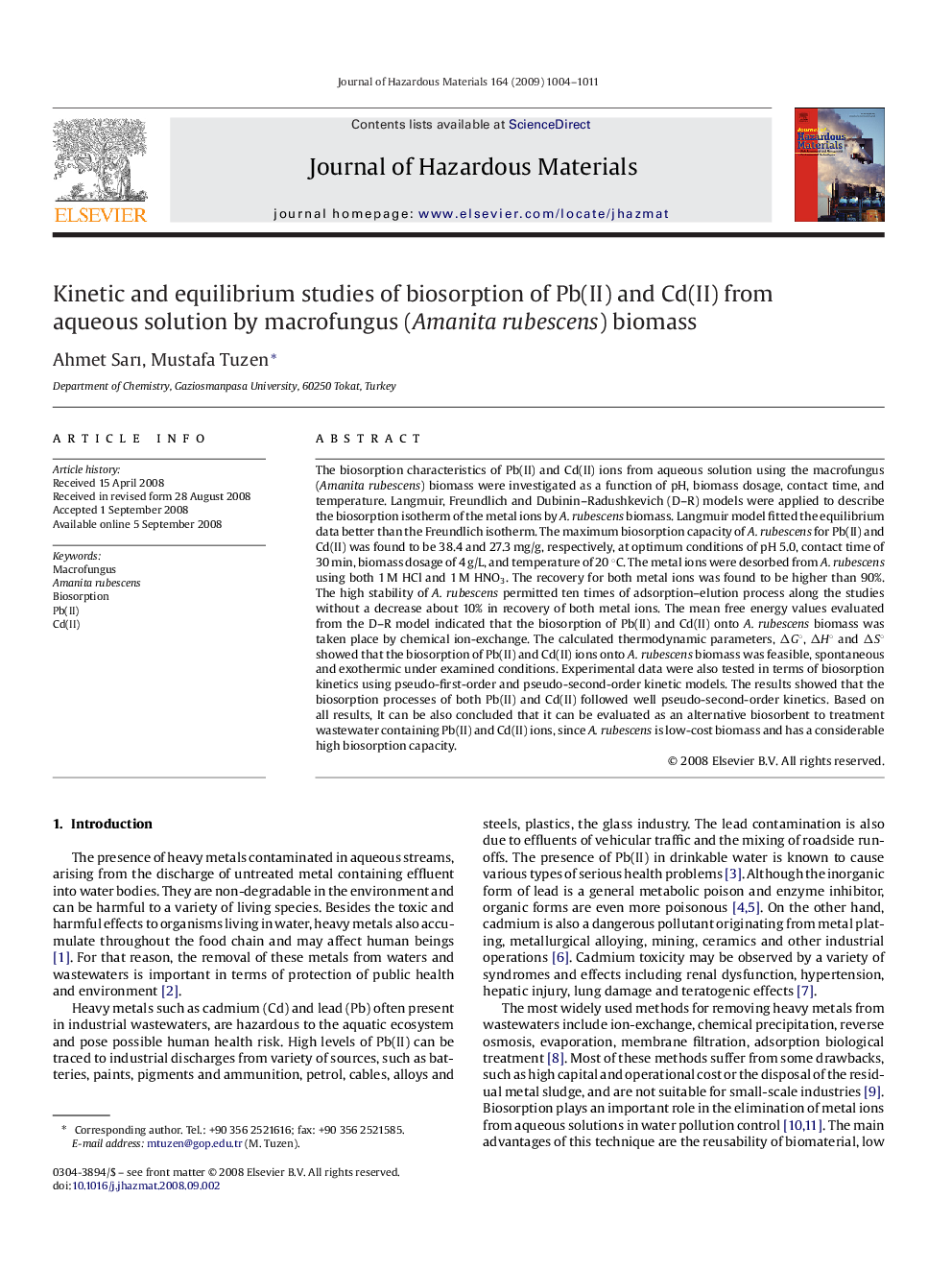| کد مقاله | کد نشریه | سال انتشار | مقاله انگلیسی | نسخه تمام متن |
|---|---|---|---|---|
| 582524 | 1453164 | 2009 | 8 صفحه PDF | دانلود رایگان |
عنوان انگلیسی مقاله ISI
Kinetic and equilibrium studies of biosorption of Pb(II) and Cd(II) from aqueous solution by macrofungus (Amanita rubescens) biomass
دانلود مقاله + سفارش ترجمه
دانلود مقاله ISI انگلیسی
رایگان برای ایرانیان
موضوعات مرتبط
مهندسی و علوم پایه
مهندسی شیمی
بهداشت و امنیت شیمی
پیش نمایش صفحه اول مقاله

چکیده انگلیسی
The biosorption characteristics of Pb(II) and Cd(II) ions from aqueous solution using the macrofungus (Amanita rubescens) biomass were investigated as a function of pH, biomass dosage, contact time, and temperature. Langmuir, Freundlich and Dubinin-Radushkevich (D-R) models were applied to describe the biosorption isotherm of the metal ions by A. rubescens biomass. Langmuir model fitted the equilibrium data better than the Freundlich isotherm. The maximum biosorption capacity of A. rubescens for Pb(II) and Cd(II) was found to be 38.4 and 27.3 mg/g, respectively, at optimum conditions of pH 5.0, contact time of 30 min, biomass dosage of 4 g/L, and temperature of 20 °C. The metal ions were desorbed from A. rubescens using both 1 M HCl and 1 M HNO3. The recovery for both metal ions was found to be higher than 90%. The high stability of A. rubescens permitted ten times of adsorption-elution process along the studies without a decrease about 10% in recovery of both metal ions. The mean free energy values evaluated from the D-R model indicated that the biosorption of Pb(II) and Cd(II) onto A. rubescens biomass was taken place by chemical ion-exchange. The calculated thermodynamic parameters, ÎG°, ÎH° and ÎS° showed that the biosorption of Pb(II) and Cd(II) ions onto A. rubescens biomass was feasible, spontaneous and exothermic under examined conditions. Experimental data were also tested in terms of biosorption kinetics using pseudo-first-order and pseudo-second-order kinetic models. The results showed that the biosorption processes of both Pb(II) and Cd(II) followed well pseudo-second-order kinetics. Based on all results, It can be also concluded that it can be evaluated as an alternative biosorbent to treatment wastewater containing Pb(II) and Cd(II) ions, since A. rubescens is low-cost biomass and has a considerable high biosorption capacity.
ناشر
Database: Elsevier - ScienceDirect (ساینس دایرکت)
Journal: Journal of Hazardous Materials - Volume 164, Issues 2â3, 30 May 2009, Pages 1004-1011
Journal: Journal of Hazardous Materials - Volume 164, Issues 2â3, 30 May 2009, Pages 1004-1011
نویسندگان
Ahmet Sarı, Mustafa Tuzen,